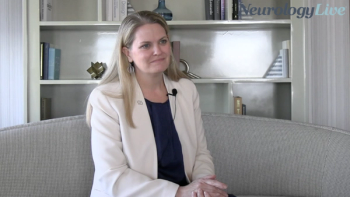
Distinct MRI Features Identified Between AQP4-NMOSD and MOG-Antibody Disease
Lesions in the canalicular and intracranial optic nerve, area postrema, medulla, and cervical spinal cord were prominent in patients with aquaporin-4–NMOSD.
A recently published systematic review and meta-analysis identified distinct MRI features between patients with MOG-antibody disease (MOG-AD) and aquaporin-4 neuromyelitis optica spectrum disorder (AQP4-NMOSD) that may guide clinicians in the choice of antibody testing and address the differential diagnosis.
Lead author Tiziana Carandini, MD, neurologist, Fondazione IRCCS, Granda Ospedale Maggiore Policlinico, and colleagues included 14 case-series studies (n = 1028) that compared MRI lesion patterns in optic nerve (ON), brain, and spinal cord (SC) between patients with MOG-AD and AQP4-NMOSD. MRI data concerning contrast-enhancement patterns were excluded, as well as those radiological features linked to an appropriate participants’ follow-up.
Comparisons between groups showed that retrobulbar lesions predominated in patients with MOG-AD (OR, 5.67 [95% CI, 2.11-15.24]; P = .00006), with moderate evidence of heterogeneity (I2 = 45%). Conversely, results demonstrated a slight predominance of both canalicular (OR, 0.42 [95% CI, 0.18-0.98] P = .05) and intracranial lesions (OR, 0.30 [95% CI, 0.11-0.84]; P = .02) for patients with AQP4-NMOSD, with no heterogeneity for both outcomes (I2 = 0%).
"In conclusion, an early differentiation of MOG from AQP4 has important implications for prognostic and therapeutic purposes," Caradini et al wrote. "A standardization of CNS sites terminology is mandatory to obtain a more comprehensive differentiation of topographical patterns of MRI lesions of MOG and AQP4 in future studies.”
READ MORE:
Despite finding no significant differences when considering the whole ON swelling (OR, 1.69 [95% CI, 0.81-3.53]; P = 0.16), investigators conversely observed significantly more frequent ON swelling in those with MOG (OR, 8.20 [95% CI, 4.13-16.28]; P <.00001).
Data on SC lesions in MOG and AQP4-NMOSD revealed a predominance in the AQP4-group (OR, 0.25 [95% CI, 0.11-0.59]; P = .001), despite substantial heterogeneity (I2 = 60%). No differences were observed on SC central GM involvement between the 2 groups. Data on cervical-SC lesions, extracted from 3 studies, showed higher frequency among those with AQP4-NMOSD (OR, 0.29 [95% CI, 0.09-0.92]; P = 0.04; I2 = 11%), while patients with MOG showed a higher incidence of lumbar/conus lesions (OR, 3.47 [95% CI, 1.66-7.24]; P = .00009; I2 = 0%).
Patients with AQP4-NMOSD reported a significantly higher incidence of lesions within the area postrema (OR, 0.12 [95% CI, 0.02-0.61]; P = 0.007; I2 = 63%) and medulla (OR, 0.40 [95% CI, 0.20-0.78]; P = 0.007; I2 = 23%). Conversely, patients with MOG-AD showed higher incidence of pons lesions (OR, 2.87 [95% CI, 1.45-5.67]; P = 0.002; I2 = 4%) and a trend towards significance for midbrain lesions (OR, 1.86 [95% CI, 0.97-3.57]; P = 0.06; I2 = 0%).
Despite high heterogeneity (I2 = 86%), the incidence of fourth ventricle length (4thVL) did not differ between groups (OR, 1.26 [95% CI, 0.17-9.58]; P = 0.82); although, in the sensitivity analysis that excluded the only study that was performed in Asia and included pediatrics, significantly higher 4thVL was observed in patients with MOG-AD (OR, 2.73 [95% CI, 1.03-7.22]; P = .04; I2 = 0%).
Investigators found no differences between the 2 groups on chiasm lesions (OR, 0.66 [95% CI, 0.18-2.42]; P = 0.53], with substantial heterogeneity (I2 = 58%). Similarly, incidence of optic tract lesions did not differ between the 2 diseases (OR, 0.67 [95% CI, 0.17-2.66]; P = .057).
"Further neuropathological studies are also paramount to correlate MRI findings with the histopathology of the 2 diseases,” Carandini et al wrote. There remains a need for an additional effort to understand more about NMOSD and how the disease progresses. In the video below, Brian G. Weinshenker, MD, professor of neurology, Mayo Clinic College of Medicine, details the lesser-known facts about the disease and how it evolves over time.
REFERENCE
Carandini T, Sacchi L, Bovis F, et al. Distinct patterns of MRI lesions in MOG antibody disease and AQP4 NMOSD: a systematic review and meta-analysis. Mult Scler Relat Disord. Published online June 30, 2021. doi: 10.1016/j.msard.2021.103118
Newsletter
Keep your finger on the pulse of neurology—subscribe to NeurologyLive for expert interviews, new data, and breakthrough treatment updates.


































